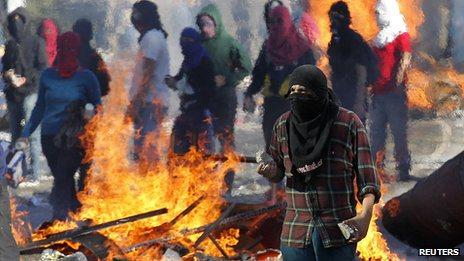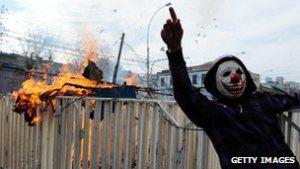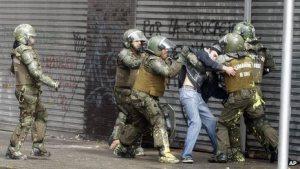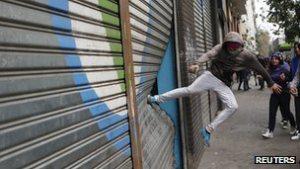
[the following report on anarchist and violent protest in Chile was produced by a corporate news source, and while informed and detailed, the opinions therein do not reflect the opinions of the Earth First! Journal. It is cross-posted for discussion and analysis]
by Gideon Long / BBC News
They turn up to almost every demonstration in the Chilean capital Santiago and hurl stones, petrol bombs and even acid at the police.
They spray the walls of the city with graffiti and attack journalists who try to film or photograph them.
They are the “encapuchados” or “hooded ones”, and they have become a regular feature of the protests that have convulsed Chilean society over the past two years.
During that time, students have staged scores of demonstrations across the country. Environmentalists, gay rights activists, copper miners and members of Chile’s indigenous communities have also taken to the streets to air their grievances.
The vast majority of these people march peacefully, but often their protests end in violence. Small groups of young men, their identities hidden under hoods and behind bandanas, confront the police, who respond with tear gas, batons and water cannon.
Thousands of people have been arrested and hundreds injured.
Media coverage of the protests tends to focus on the clashes rather than the peaceful marches that precede them.
As a result, the issues at stake – the environment, gender equality, indigenous rights and above all education – often get overlooked. Instead, the debate focuses on police tactics and law and order.
The leaders of the student movement are acutely aware of this. Opinion polls consistently show that while many Chileans support their demands for education reform, they deplore the violence and vandalism that accompany the marches.
“The important thing for us is to keep talking about education,” says Andres Fielbaum, president of the students’ union at the University of Chile. “We have to remember that the people who cause the violence are less than 1% of those on the marches.”
That is true, but that “less than 1%” has a disproportionate impact in the media, and is tarnishing the reputation of the entire movement.

A growing number of anarchists are said to be joining the movement
‘Head-on fight’
So who are the hooded ones and what do they want?
Gabriel Salazar, a left-wing historian and university lecturer who has followed the protests for the past two years, identifies two sub-groups within their ranks.
“The vast majority are from poor neighbourhoods of Santiago and are in higher education, many of them at technical colleges,” he says.
“They come from communities with a long tradition of protest, dating back to the Pinochet dictatorship. Violent protest is almost routine for them.”
But Mr Salazar also identifies a second, smaller group, from slightly wealthier backgrounds, who are more recent converts to violence. He says they are anarchists engaged in “a head-on fight against the system”.
Black-and-red anarchist flags are certainly visible on many of the marches.
“Anarchism has grown in a lot of Chilean universities, including in this one,” says Alberto Mayol, a sociologist at the University of Chile, one of Chile’s two most prestigious seats of learning.
“The state can’t control what people wear or use during demonstrations; that’s protected by freedom of expression”Ana Piquer Amnesty International ChileMr Mayol sees a direct line of descent from the anti-Pinochet protesters of the 1980s to the student activists of today. “What we’re seeing now is the end of the end of the post-dictatorship era,” he says.
The violence is by no means limited to the student demonstrations. This year’s May Day workers’ march ended in fierce clashes in central Santiago: 141 people were arrested and 42 police officers injured.
Police are not the only targets. Banks, pharmacies and fast food outlets have been trashed.
The hooded ones do not take kindly to the intrusion of what they regard as “the bourgeois media”.
On 1 May, they attacked a van belonging to Chilean television channel Canal 13, injuring a driver and a cameraman. During a student demonstration on 8 May, they assaulted a CNN journalist.
The aims of these violent protesters are difficult to assess. Some seem to be fighting for revolution, while others are fighting just for fun.
Sociologists say many are angry young men marginalised by Chile’s capitalist economic model, which has brought prosperity but left some of its citizens vulnerable to the vagaries of the free market.
Legal crackdown

So what can be done to stop the violence?
The government says new legislation is needed. It has sent a bill to parliament to toughen penalties for public disorder offences.
If it becomes law, anyone found guilty of violent protest will have their sentence increased if they are also found to have covered their face, thereby preventing police identification.
The draft legislation is controversial and has been criticised by human rights groups, including Amnesty International. Peaceful marchers say they are often obliged to cover their faces to protect themselves from police tear gas.
“The state can’t control what people wear or use during demonstrations,” says Ana Piquer, executive director of Amnesty International Chile. “That’s protected by freedom of expression.”
The students accuse the police of using tear gas and water cannon indiscriminately. During recent clashes, the police have fired paintballs at rioters to try to identify them. Several people have been hit in the face and at least one man has lost his sight in one eye as a result.
Earlier this month, a judge accused the police of using “methods akin to a dictatorship” during the protests – loaded words given Chile’s dark history.
Opposition politician Gabriel Silber drew a parallel between the tactics employed by police and those used during the 1973-1990 dictatorship of Augusto Pinochet.
Learning from mistakes

Many Santiago residents are exasperated by the destruction tearing apart their city
Despite this, there are some signs that co-operation between the police and the student movement is improving.
After the demonstration of 8 May, the head of Santiago’s regional government, Juan Antonio Peribonio, praised the student unions for their efforts to police their own march.
At the University of Chile, Mr Fielbaum acknowledges that the movement has learned from its mistakes during the past two years and is getting better at marshalling its demonstrations.
But the violent clashes still exasperate many Santiago residents. The face of the city has changed since 2011. There is more graffiti, and many streets no longer carry street signs. They have been torn down by rioters and thrown at the police.
On 11 April, during one student protest, a 74-year-old woman, Monica Araya, took matters into her own hands, marched up to a group of masked youths and remonstrated with them as they tried to rip a lamp post out of the ground.
Her efforts did little good – the violence continued – but Mrs Araya was widely applauded for taking a stand. For a moment at least, Chile’s hooded ones met their match.

